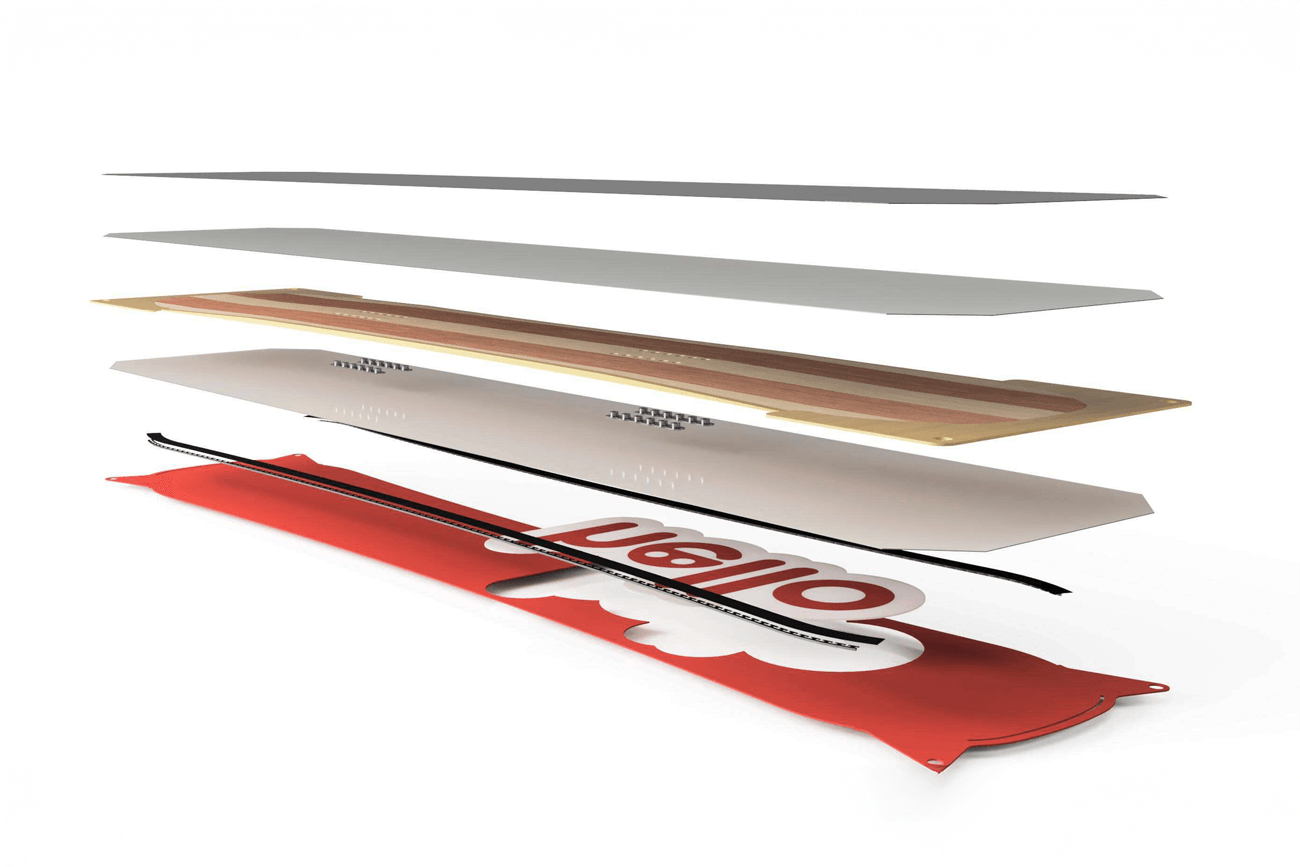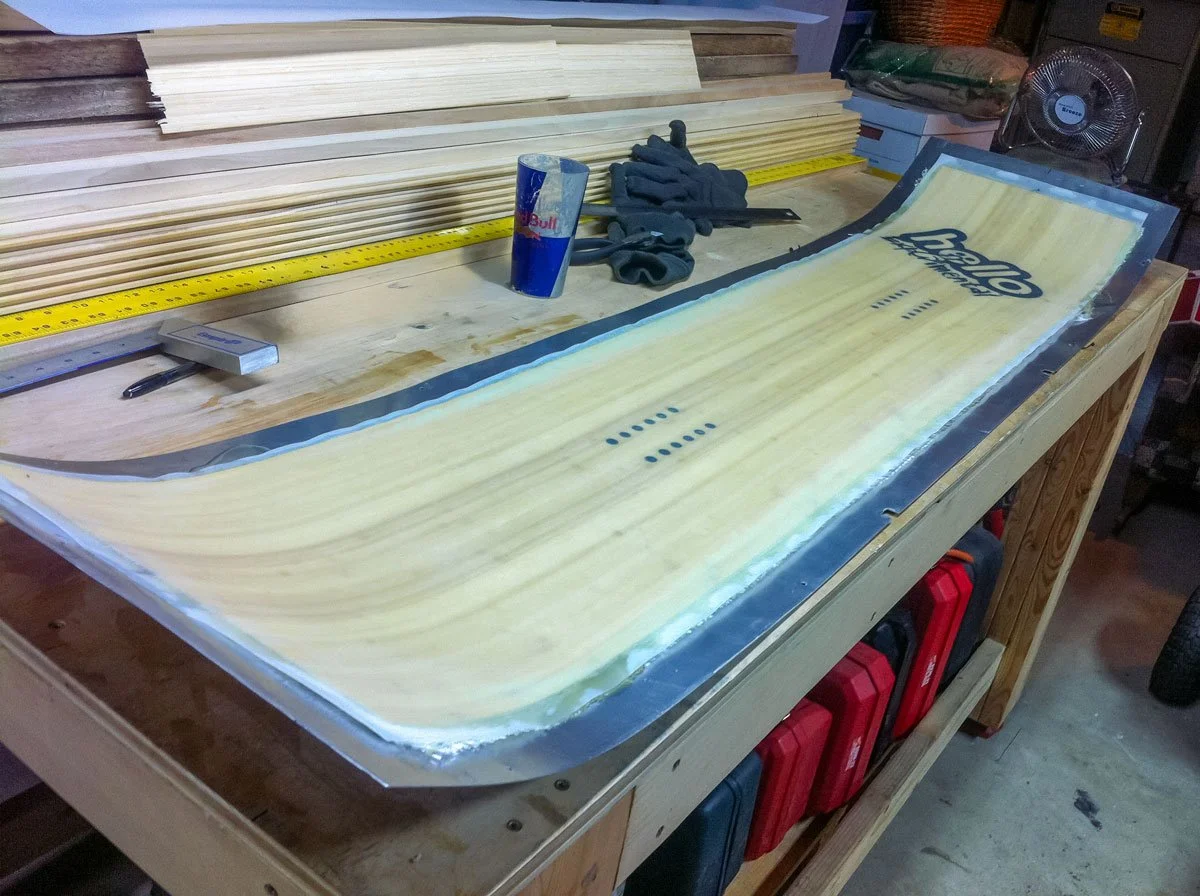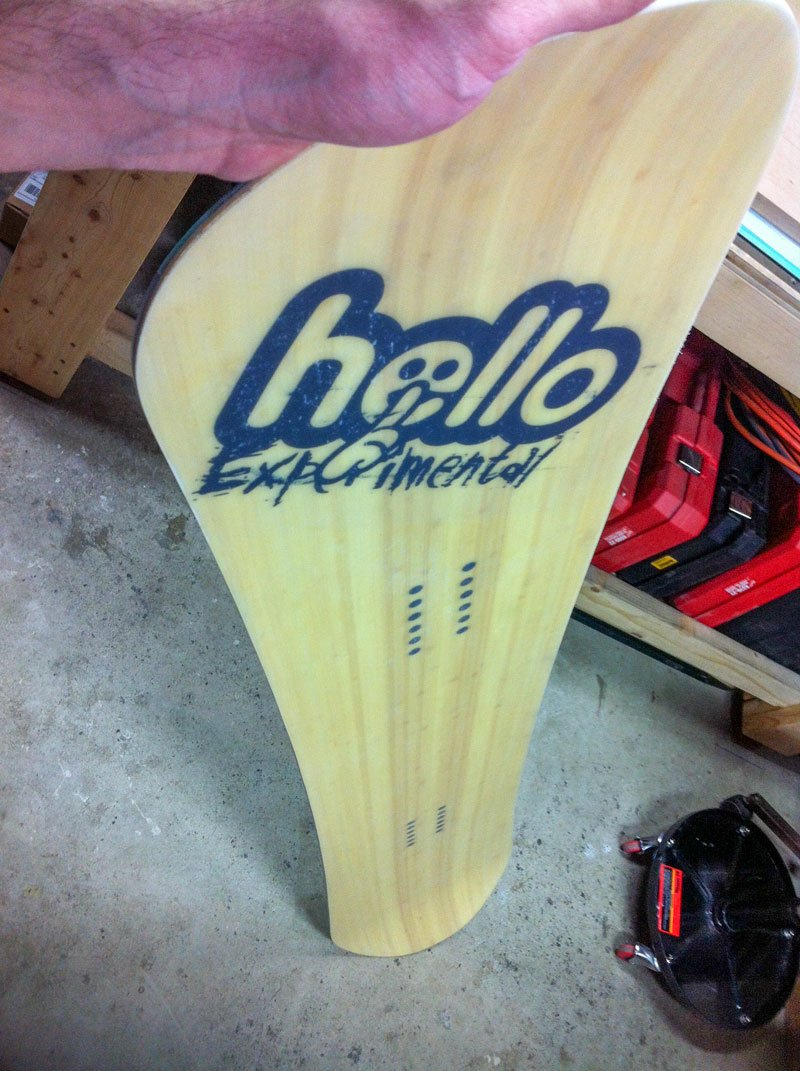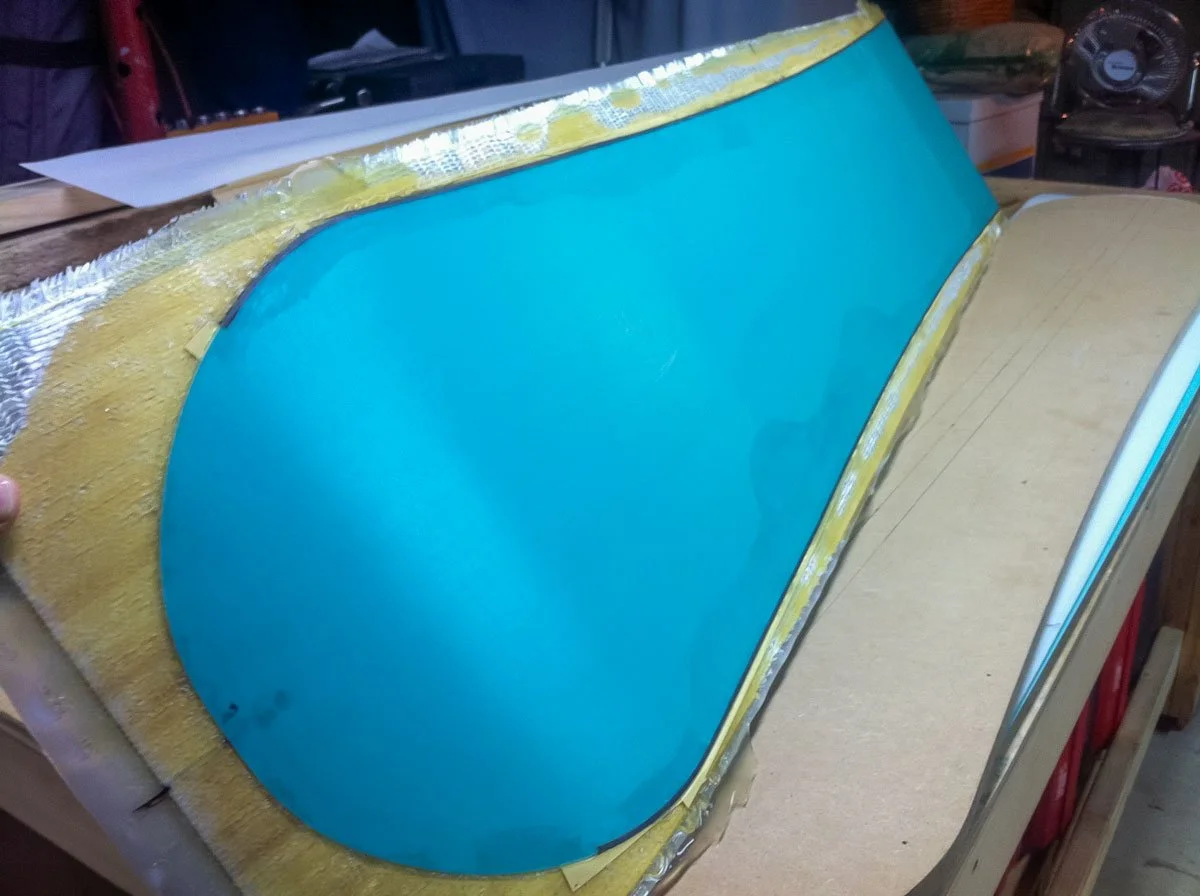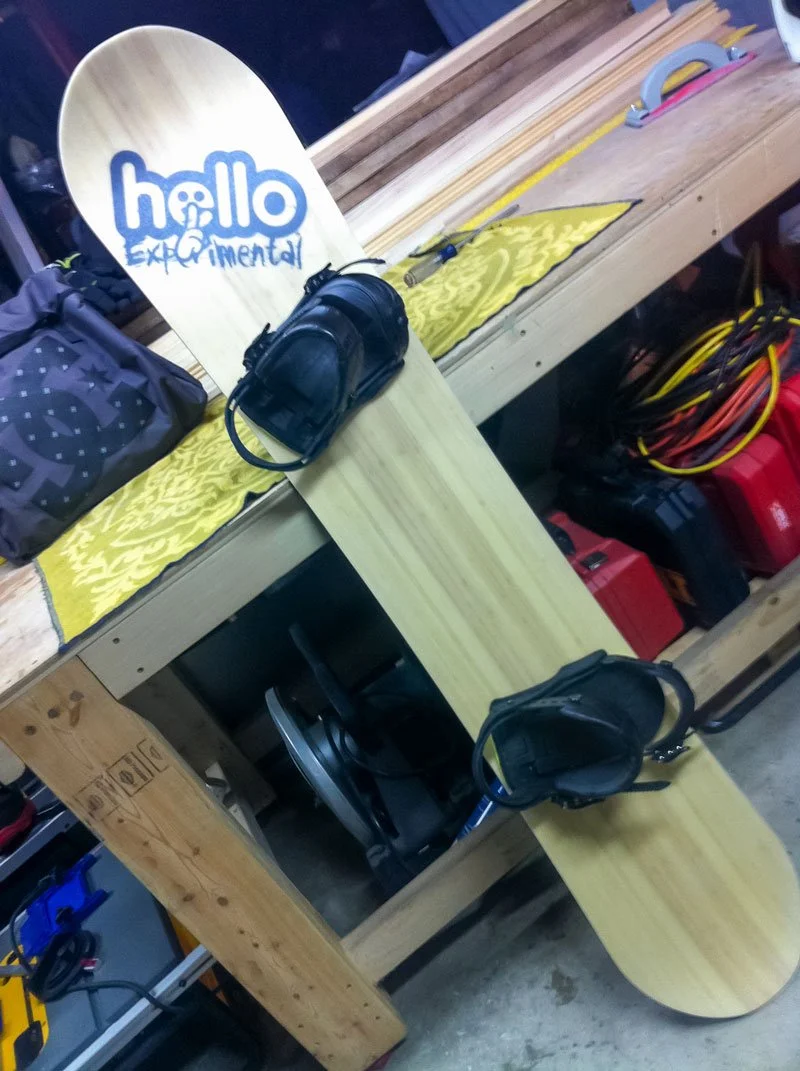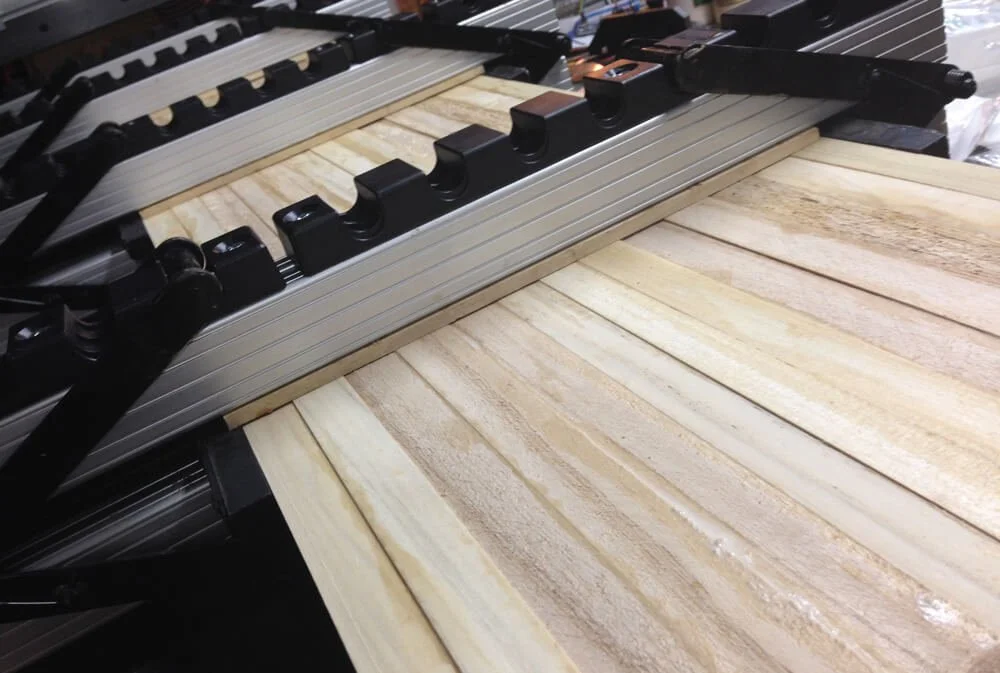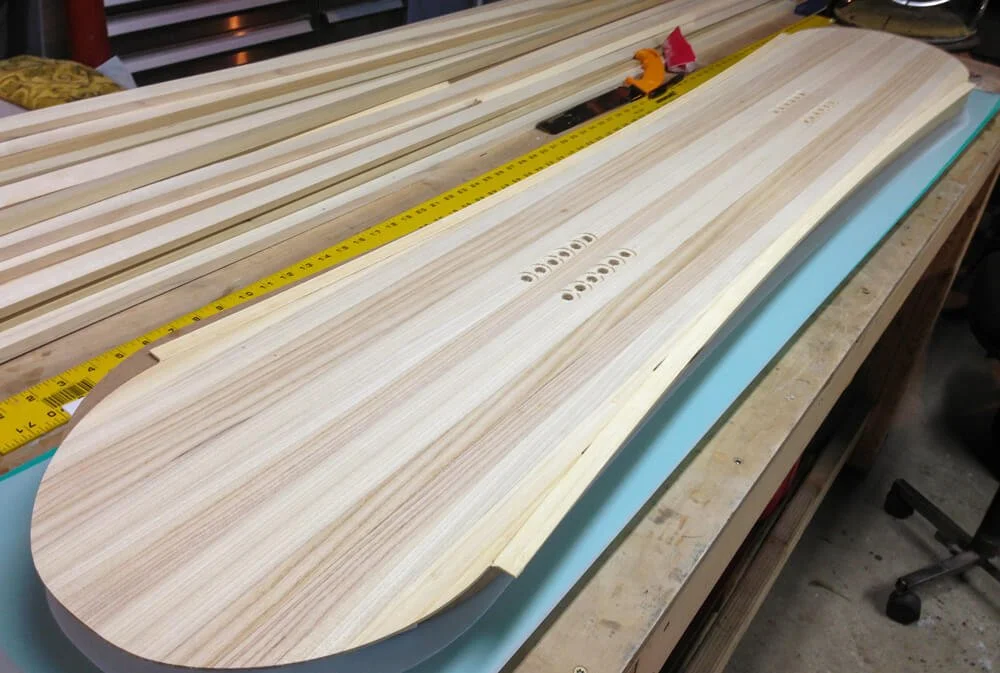All Mountain Snowboard
The Project: Build a fuckin’ snowboard
Technical documentation for building a custom all-mountain snowboard using sustainable materials, innovative construction methods, and snowboard-specific engineering principles. Covers material selection, CNC fabrication, graphics application, and the complete R&D process.
Abstract
This project focuses on developing a high-performance all-mountain snowboard through thoughtful design optimization, advanced material selection, and precision manufacturing techniques. Through extensive research and development, a refined construction approach was implemented utilizing high-performance materials including lightweight Paulownia wood cores, bamboo sidewalls, and advanced composite systems. The resulting design demonstrates how careful attention to geometry, material properties, and construction methods can produce exceptional snowboard performance.
1. Introduction
1.1 Problem Statement
For many years, snowboard design suffered from a fundamental misconception in the industry. Numerous manufacturers approached snowboard construction by simply widening ski designs, applying ski-based engineering principles to a fundamentally different application. While not universal, this practice was widespread throughout the industry.
1.2 Fundamental Design Philosophy
Skis and snowboards operate under fundamentally different biomechanical principles and force distributions. Effective snowboard design requires recognition of these differences and application of snowboard-specific engineering approaches rather than adapted ski methodologies.
1.3 Project Objectives
The scope of this project encompassed:
Design and engineer a high-performance all-mountain snowboard
Minimize board weight without compromising structural integrity
Select premium materials optimized for snowboard construction
Develop construction methods optimized specifically for snowboard performance characteristics
2. Research and Development Process
2.1 R&D Methodology
Extensive research and development was conducted across multiple design iterations, exploring various approaches to:
Board geometry and flex patterns
Core construction materials and layup configurations
Composite reinforcement strategies
Manufacturing process optimization
2.2 Prototype Phase
The prototype phase served as the primary vehicle for testing and refining design concepts. Multiple iterations allowed for systematic evaluation of:
Geometric parameters and their performance implications
Material combinations and their structural characteristics
Manufacturing techniques and their consistency
On-snow performance across varied conditions
Areas that were constantly under experimentation were:
Tip and Tail shapes
Core profiles
Core materials
Mold profiles
Sidewall materials
Topsheet and base materials
2.3 The First Board
The first board popped out of the press and exceeded expectations. The bamboo core was great for soaking up bumps and ruts. It also carved groomers like it was on rails. It was easy to layup too and that was good for production, but overall the board was too heavy, you really noticed it hanging on your foot while stuck on the lift. It also lacked any kind of pop in its flex in it’s buttery flex pattern.
3. Material Selection and Engineering
3.1 Core Construction
3.1.1 Material Selection Criteria
Core material selection prioritized three key factors:
Structural Performance: Adequate strength-to-weight ratio for all-mountain use
Weight Optimization: Minimal density without compromising integrity
Workability: Ease of machining and bonding characteristics
3.1.2 Selected Materials
A hybrid core construction was developed utilizing:
Poplar Wood
Provides structural strength and traditional flex characteristics
Established performance record in snowboard construction
Excellent bonding properties
Paulownia Wood
Exceptional strength-to-weight ratio
Significantly lighter than traditional core materials
Superior stiffness-to-weight characteristics
3.2.1 Crown Plastics System
Crown Plastics was selected for both base and topsheet applications based on:
Proven durability in snowboard applications
Consistent manufacturing properties
Industry-standard performance characteristics
Durasurf 2001 or 4001 for base material
Durasurf PE Blend 0.020 topsheet
3.3 Sidewall Innovation
3.3.1 Departure from Industry Standard
The design deliberately diverged from the industry-standard practice of plastic sidewalls, implementing an innovative alternative material.
3.3.2 FSC-Certified Bamboo Sidewalls
Bamboo was selected as the sidewall material, representing a significant departure from conventional construction:
Superior strength characteristics in sidewall applications
Exceptional toughness and impact resistance
Enhanced bonding strength compared to plastic alternatives
Improved mechanical adhesion properties
Natural aesthetic that complements wood core visibility
3.4 Composite Reinforcement System
3.4.1 Fiberglass Selection
Vectroply E TLX 1900 Triaxial Fiberglass was specified for structural reinforcement:
Triaxial weave provides multidirectional strength
Optimized fiber orientation for snowboard load patterns
Superior torsional rigidity compared to biaxial alternatives
3.2 Base and Topsheet Materials
3.4.2 Resin System
Entropy Resins CPM bio-based epoxy system was selected to maintain environmental objectives:
Partially bio-based resin formulation
Reduced VOC emissions during manufacturing
Excellent wet-out characteristics for fiberglass lamination
Superior bond strength across all materials
Consistent cure properties for reliable manufacturing
4. Design Optimization
4.1 Geometric Development
Board geometry underwent iterative refinement throughout the R&D phase, addressing:
Sidecut radius and effective edge optimization
Flex pattern distribution and progression
Nose and tail shape for varied snow conditions
Stance positioning and reference points
4.1 Pressing Methods
Manufacturing processes were developed and refined to ensure:
Consistent laminate compression across the board profile
Optimal resin distribution and fiber wet-out
Repeatable geometric accuracy
Minimal void formation in composite structures
4.3 Lay-up Techniques
Lamination procedures were systematically optimized for:
Proper fiber orientation and layer sequencing
Efficient production workflow
Quality consistency across production runs
Minimization of material waste
4.4 CNC Machining and Fabrication
A custom CNC router was constructed utilizing components from AvidCNC to provide precision machining capabilities essential to consistent board production.
System Applications:
Core cutting and profiling
Precision shaping of core geometries
Consistent dimensional accuracy across production
Efficient material utilization
Component Source: avidcnc.com
4.4.1 Custom CNC Router System
Base material cutting was accomplished using the custom CNC router equipped with a Donek drag knife system.
Donek Drag Knife Advantages:
Clean, precise cuts in base material
Eliminates need for manual cutting and trimming
Repeatable accuracy for consistent board profiles
Reduced material waste through optimized toolpathing
Component Source: donek.com
4.4.2 Base Material Cutting
The CNC machining capability proved essential to the project's success by:
Ensuring geometric consistency across all board components
Reducing manual labor and potential human error
Enabling rapid prototyping during R&D phase
Supporting efficient transition from prototype to production
The investment in custom CNC infrastructure provided manufacturing capabilities typically reserved for larger production facilities, demonstrating that precision board building is achievable at smaller scales with appropriate tooling.
4.4.3 Manufacturing Integration
5. Graphics and Topsheet Decoration
5.1 Design Approach
The aesthetic design strategy emphasized the natural beauty of the wood core construction. By utilizing a clear topsheet material, the visual character of the Poplar and Paulownia core remains visible, creating a distinctive organic appearance that celebrates the board's construction rather than concealing it.
5.2 Graphics Application Methods
5.2.1 Selected Method: Epoxy Screen Printing
Epoxy-Based Screen Printing Ink was selected as the primary graphics application method:
Process Characteristics:
Single-color format application
Epoxy ink chemistry compatible with resin system
Direct application to topsheet surface
Minimal visual obstruction of core visibility
Design Philosophy: The single-color approach complements rather than dominates the natural wood aesthetic, allowing the core's visual characteristics to remain the primary design element while adding branded or decorative elements where desired.
5.2.2 Alternative Method: Dye Sublimation
Dye sublimation represents a high-volume production approach offering:
Advantages:
Full-color, photographic-quality graphics
Highly durable image integration
Professional production appearance
Consistent repeatability across production runs
Implementation Barriers:
Significant capital equipment investment required
Complex engineering and process development
Substantial technical expertise necessary
Heat press equipment and specialized transfer systems
Project Decision: While dye sublimation offers aesthetic versatility, the capital requirements and engineering complexity exceeded the project's resource allocation and immediate production needs.
An innovative, cost-effective graphics method adapted from surfboard manufacturing:
Process Overview:
Standard inkjet printing on specialized rice paper
Rice paper positioned in lamination stack beneath topsheet
Integration into composite during pressing cycle
Resin saturation renders rice paper substrate invisible
Method Advantages:
Minimal capital investment (standard inkjet printer)
Full-color graphics capability
Easy customization and design iteration
Proven effectiveness in surfboard applications
Technical Considerations:
Rice paper selection critical for proper transparency
Proper resin saturation essential for substrate invisibility
Positioning accuracy important during layup
Ink compatibility with epoxy resin system
Application Suitability: This method provides an accessible entry point for custom graphics and small-batch production, offering professional results without the capital investment required for dye sublimation systems.
5.2.3 Alternative Method: Rice Paper Inkjet Transfer
5.3 Graphics Method Comparison
| Method | Cost | Complexity | Color Options | Visual Result | Best For |
|---|---|---|---|---|---|
| Epoxy Screen Print | Low | Low | Single color | Clean, minimal | Emphasizing natural core visibility |
| Dye Sublimation | High | High | Full color | Professional, photographic | High-volume production |
| Rice Paper Inkjet | Very Low | Low | Full color | Custom, detailed | Custom builds, small batches |
6. Results and Performance Analysis
6.1 Design Achievement
The R&D process successfully yielded a refined snowboard design incorporating:
Optimized geometry specific to snowboard performance requirements
Lightweight construction without structural compromise
Environmentally responsible material selection throughout
Manufacturing processes capable of consistent production
Flexible graphics options accommodating various aesthetic approaches
6.2 Material Performance
The selected material combination demonstrated:
Excellent strength-to-weight characteristics
Superior bonding performance, particularly with bamboo sidewalls
Reliable structural integrity across varied conditions
Environmental benefits without performance penalties
6.3 Manufacturing Success
Developed pressing and lay-up methods proved:
Repeatable and consistent across production
Capable of maintaining tight geometric tolerances
Efficient in material utilization
Scalable for increased production volume
7. Discussion
7.1 Design Philosophy Validation
The project successfully demonstrated that snowboard-specific design approaches yield superior results compared to adapted ski construction methods. By recognizing the fundamental differences in how these platforms function, the design achieved performance characteristics optimized for snowboarding biomechanics.
7.2 Innovation in Material Application
7.2.1 Bamboo Sidewall Innovation
The use of bamboo as a sidewall material represents a significant innovation delivering superior performance:
Technical Merit: The superior bonding strength and mechanical properties of bamboo validate its use based purely on performance considerations. This material choice delivers genuine structural advantages over conventional plastic sidewalls.
Industry Implications: This successful application challenges the default use of plastic sidewalls and demonstrates that alternative materials can offer superior performance characteristics.
7.3 Material Selection Excellence
The project achieved its material performance objectives through:
Strategic selection of premium materials optimized for snowboard construction
Implementation of advanced composite systems
Use of lightweight core materials without performance sacrifice
Development of manufacturing processes that maximize material properties
Critically, these material choices delivered superior performance characteristics, demonstrating that innovative material selection and thoughtful engineering produce exceptional results.
7.4 Lightweight Construction
The incorporation of Paulownia wood core sections successfully reduced board weight while maintaining structural requirements for all-mountain performance. This weight reduction enhances:
Rider maneuverability and control
Reduced fatigue during extended use
Improved swing weight for aerial maneuvers
Enhanced responsiveness in varied conditions
7.5 Graphics Flexibility
The project successfully identified and evaluated multiple graphics application methods, each serving different production scenarios:
Epoxy Screen Printing proved ideal for the project's aesthetic philosophy, allowing the natural core beauty to remain the dominant visual element while providing branding capability.
Rice Paper Inkjet Transfer emerged as a valuable discovery, offering a low-barrier entry to custom graphics that democratizes access to professional-looking results without significant capital investment. This method's adaptation from surfboard manufacturing demonstrates the value of cross-industry innovation.
Dye Sublimation remains a future consideration for scaled production, with its capital requirements and complexity acknowledged but deferred pending production volume justification.
This multi-method approach provides flexibility across different production scales and customer requirements, from one-off custom builds to potential production runs.
8. Conclusion
This project successfully developed a high-performance all-mountain snowboard that challenges conventional industry approaches on multiple fronts. By rejecting the historical practice of adapting ski design principles to snowboard construction, the design achieves performance characteristics specifically optimized for snowboarding biomechanics.
The extensive R&D process yielded refined solutions across all design aspects: geometry, material selection, and manufacturing processes. The resulting snowboard demonstrates that environmental responsibility and lightweight construction can be achieved without compromising performance when approached through thoughtful engineering and material science.
The innovative use of FSC-certified bamboo sidewalls, combined with Paulownia core sections and bio-based resin systems, establishes a template for sustainable snowboard construction that delivers genuine performance advantages. The developed manufacturing processes ensure these design innovations can be consistently reproduced, supporting both custom builds and potential scaled production.
9. Technical Summary
| Component | Material/Specification | Key Characteristics | Manufacturer |
|---|---|---|---|
| Core Material (Primary) | Poplar | Structural strength, traditional flex | — |
| Core Material (Secondary) | Paulownia | Lightweight, exceptional strength-to-weight ratio | — |
| Sidewalls | Bamboo | Superior bonding, high strength, natural aesthetic | — |
| Steel Edges | Steel | Precision edge hold and durability | waelzholz.com |
| Base Material | Crown Plastics | Industry-standard durability | crownplastics.com |
| Topsheet Material | Crown Plastics | Proven performance characteristics | crownplastics.com |
| Reinforcement | Vectorply E TLX 1900 Triaxial Fiberglass | Multidirectional strength, optimized torsion | vectorply.com |
| Resin System | Entropy Resins | High-performance epoxy, superior bond strength | entropyresins.com |
| Design Category | All-Mountain | Versatile performance across conditions | — |
| Design Philosophy | Iterative design refinement | Optimized through extensive R&D and testing | — |
| CNC Router System | Custom-built with AvidCNC components | Core cutting, shaping, precision fabrication | avidcnc.com |
| Base Cutting Tool | Donek Drag Knife | Precise base material cutting on CNC | donek.com |
| Graphics Method (Selected) | Epoxy Screen Printing Ink | Single-color, preserves core visibility | — |
| Graphics Method (Alternative 1) | Dye Sublimation | Full-color, high-volume capability | — |
| Graphics Method (Alternative 2) | Rice Paper Inkjet Transfer | Full-color, low-cost custom graphics | — |

